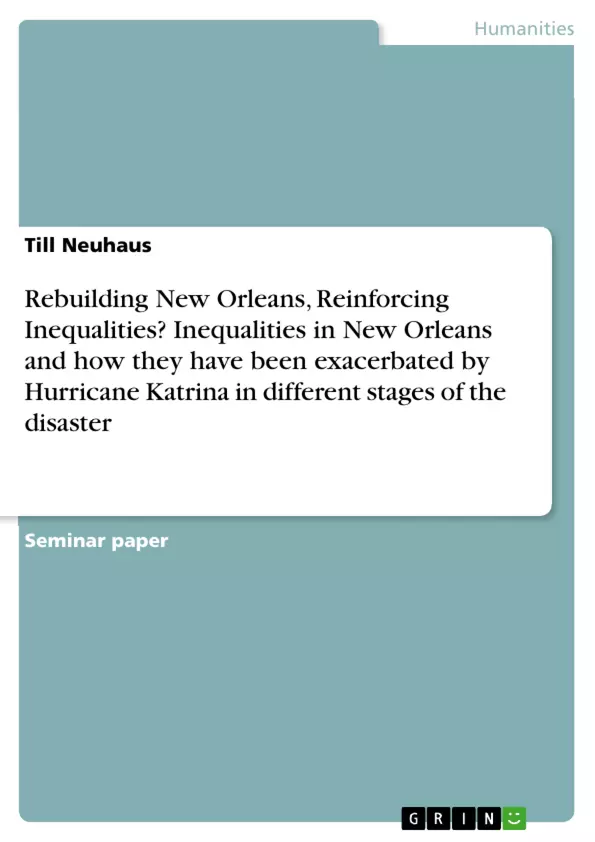This paper wants to contribute by taking a closer look at the inter-linkages of different forms of inequality and how they influenced and caused each other in different stages of the disaster. Therefore, the time before the hurricane, the time-span of re-migration, and New Orleans’ long-term development will be analyzed with regard to their specific importance for the exacerbation of inequalities.
Some scholars argue that “[c]limate change has become part of high politics”. The scientific community agrees that climate change is partly responsible for the increase of extreme weather phenomena even though climate change’s impact factor cannot be exactly determined. People all around the world are exposed to extreme weather conditions and it can generally be assumed that “[t]here will always be crisis, catastrophes and uncertainty”. People try to lessen the impact of natural hazards and while almost all communities and countries are statistically affected by those hazards, their responses differ massively. One strategy to lessen the impact of those “[r]are, if not unique, and as striking rarely and without warning” phenomena is migration. “Environmental migration is not a new phenomenom. [...] However, global climate change threatens to significantly increase human movement, both within states and across international borders”.
A lot of research has been dedicated to identifying and differentiating between mitigation and adaption strategies, however, less attention has been invested into the resettlement of and in urban areas. Further, it should be noticed that due to the on-going trend of urbanization, the city as a matter of analysis of climate-induced migration will steadily gain importance and due to rising sea levels, coastal cities are more affected by climate change and thereby by climate-induced migration than the inland. Even though numbers vary massively depending on the employed definitions concerning climate-induced migration, it can nonetheless be stated that “the populations of coastal megacities have skyrocketed” in the last couple decades and, on the basis of those tendencies, it can be concluded that more people will consequently be affected by climate-related phenomena in the future.
Inhaltsverzeichnis (Table of Contents)
- 1. Introduction
- 2. Katrina as a Phenomenon of Climate-Induced Migration
- a. Katrina as a Climate Phenomenon causing Migration
- b. Victims, Damages, and Deaths caused by Katrina...
- C. The Changing Nature of Risk
- 3. New Orleans' Geography, Social Typology, and History
- a. New Orleans' Geography of Danger
- b. The Changing Nature of Risk in New Orleans
- C. New Orleans' History of Inequality
- 4. Reinforced Inequalities by Katrina
- a. Before the Storm
- b. After the Storm...
- C. Long-term Effects on New Orleans
- 5. Findings and Results
- 6. Outlook on further Research...
Zielsetzung und Themenschwerpunkte (Objectives and Key Themes)
This paper aims to analyze the inter-linkages of different forms of inequality and how they influenced and caused each other in different stages of the Hurricane Katrina disaster. It will examine the time before the hurricane, the time-span of re-migration, and New Orleans' long-term development with regard to their specific importance for the exacerbation of inequalities.
- The role of climate change in migration and the impact of Hurricane Katrina.
- The social and economic inequalities that existed in New Orleans before Katrina.
- The ways in which Hurricane Katrina exacerbated existing inequalities in New Orleans.
- The long-term impact of Katrina on the social and economic fabric of New Orleans.
- The importance of understanding the complex interplay of factors that contribute to vulnerability to natural disasters.
Zusammenfassung der Kapitel (Chapter Summaries)
- Chapter 1: Introduction This chapter introduces the concept of climate-induced migration and argues that Hurricane Katrina can be understood as a case of climate-induced migration. It also highlights the importance of understanding the interplay of factors that contribute to vulnerability to natural disasters, particularly in urban areas.
- Chapter 2: Katrina as a Phenomenon of Climate-Induced Migration This chapter examines the impact of Hurricane Katrina on New Orleans, categorizing it within the terminology of climate-migration theory. It discusses the damages caused by the hurricane and the various responses to the disaster, including evacuation and resettlement.
- Chapter 3: New Orleans' Geography, Social Typology, and History This chapter provides an overview of New Orleans' geography, its social typology, and its history of inequality. It examines the city's unique vulnerability to natural disasters and the long-standing issues of racial and class-based inequalities.
- Chapter 4: Reinforced Inequalities by Katrina This chapter examines the ways in which Hurricane Katrina exacerbated existing inequalities in New Orleans, both before and after the storm. It discusses the disproportionate impact of the hurricane on different communities and the long-term consequences for the city's social and economic landscape.
Schlüsselwörter (Keywords)
The main keywords and focus topics of this text are: climate change, migration, Hurricane Katrina, New Orleans, vulnerability, inequality, race, class, social determinants of health, disaster preparedness, disaster response, urban planning, social justice, environmental justice.
- Quote paper
- Till Neuhaus (Author), 2017, Rebuilding New Orleans, Reinforcing Inequalities? Inequalities in New Orleans and how they have been exacerbated by Hurricane Katrina in different stages of the disaster, Munich, GRIN Verlag, https://www.grin.com/document/704194



